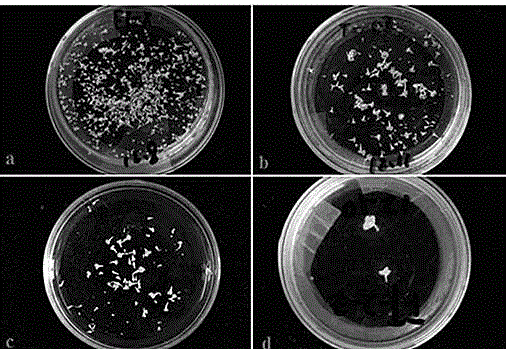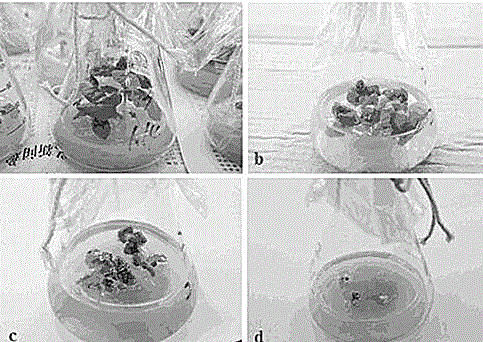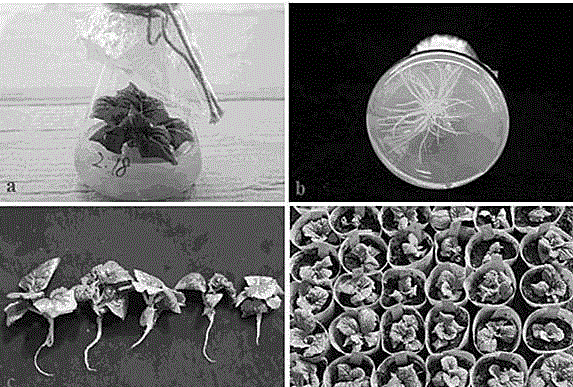A method of preparing a Chinese cabbage mutant by means of isolated microspore culture and EMS mutagenesis
A technology of microspore culture and mutants, which is applied in the field of plant cell engineering, can solve the problem of low efficiency of EMS mutagenesis seeds, and achieve the effect of improving mutagenesis efficiency and speeding up
- Summary
- Abstract
- Description
- Claims
- Application Information
AI Technical Summary
Problems solved by technology
Method used
Image
Examples
Embodiment 1
[0044] Embodiment 1, EMS mutagenesis treatment process
[0045] 1. Plant material
[0046] The mutagenic material used is the DH line obtained from the early-maturing Chinese cabbage variety 'Futian 50' through microspore culture. We named it 'FT'. It has the characteristics of heat resistance, white flowers, and oval leaf balls.
[0047] In our laboratory, Liu Yang and others used 'FT' as the experimental material, and published a paper on the mapping of quantitative traits related to yield-related traits in Chinese cabbage in the internationally important academic journal "Euphytica". The English title is "Mapping quantitative trait loci for yield-related traits in Chinese cabbage (Brassica rapa L. ssp. pekinensis)".
[0048] 2. Mutagenesis treatment
[0049] Seeds of ‘FT’ were sown in the greenhouse in September 2013 after 15 days of vernalization at 2°C. In December 2013, unopened flower buds (2-4 mm in length) whose microspore development period was late mononucleate t...
Embodiment 2
[0050] Embodiment 2, free microspore culture process
[0051] 1. Free microspore culture
[0052] After the unopened flower buds with a length of 2-4mm (the microspore development period is late mononucleate to early dinucleate) are disinfected with a concentration of 75% ethanol solution for 30 seconds in an ultra-clean workbench, use a concentration of 0.1% mercuric chloride solution Disinfect for 8 minutes, then rinse with sterile water 3 times, 5 minutes each time.
[0053] Put the sterilized flower buds into a sterilized small beaker, add sucrose at a concentration of 130g L -1 , B5 medium with a pH value of 5.8, crush the flower buds with a sterile pestle to free the microspores, filter the suspension containing the microspores with a nylon mesh with a pore size of 40 μm, collect the filtrate in a 10mL centrifuge tube, and centrifuge at 1000rpm for 3min , discard the supernatant, add 10mL B5 medium to the precipitate, shake well, centrifuge at 1000rpm for 3min, discard...
Embodiment 3
[0074] Embodiment 3, the ploidy identification process of regeneration plant population
[0075] 1. Using flow cytometry to identify the ploidy of regenerated plants
[0076] We mainly use flow cytometry to identify the ploidy of the regenerated plants and screen out the double haploid plants. First, take fresh young leaves with a diameter of 1-2 cm and put them into a petri dish, add 1.5-2.0 mL of Chopping Buffer (15 mmol·L -1 Trishydroxymethylaminomethane, 2mmol·L -1 Disodium edetate, 0.5mmol·L -1 Spermine, 80mmo1·L -1 Potassium chloride, 20mmo1·L -1 Sodium chloride, 0.1% [v / v] polyethylene glycol octylphenyl ether and 15mmo1·L -1Dimercaptoethanol, pH 7.5), cut the leaves with surgical scissors, then suck the supernatant, filter the sample into a centrifuge tube with a 300-mesh screen, centrifuge at 1000rpm for 10min, discard the supernatant after centrifugation, add 1mL PI to the precipitate ( Propidium iodide) staining solution, mixed and protected from light for 15 ...
PUM
 Login to View More
Login to View More Abstract
Description
Claims
Application Information
 Login to View More
Login to View More - R&D
- Intellectual Property
- Life Sciences
- Materials
- Tech Scout
- Unparalleled Data Quality
- Higher Quality Content
- 60% Fewer Hallucinations
Browse by: Latest US Patents, China's latest patents, Technical Efficacy Thesaurus, Application Domain, Technology Topic, Popular Technical Reports.
© 2025 PatSnap. All rights reserved.Legal|Privacy policy|Modern Slavery Act Transparency Statement|Sitemap|About US| Contact US: help@patsnap.com



